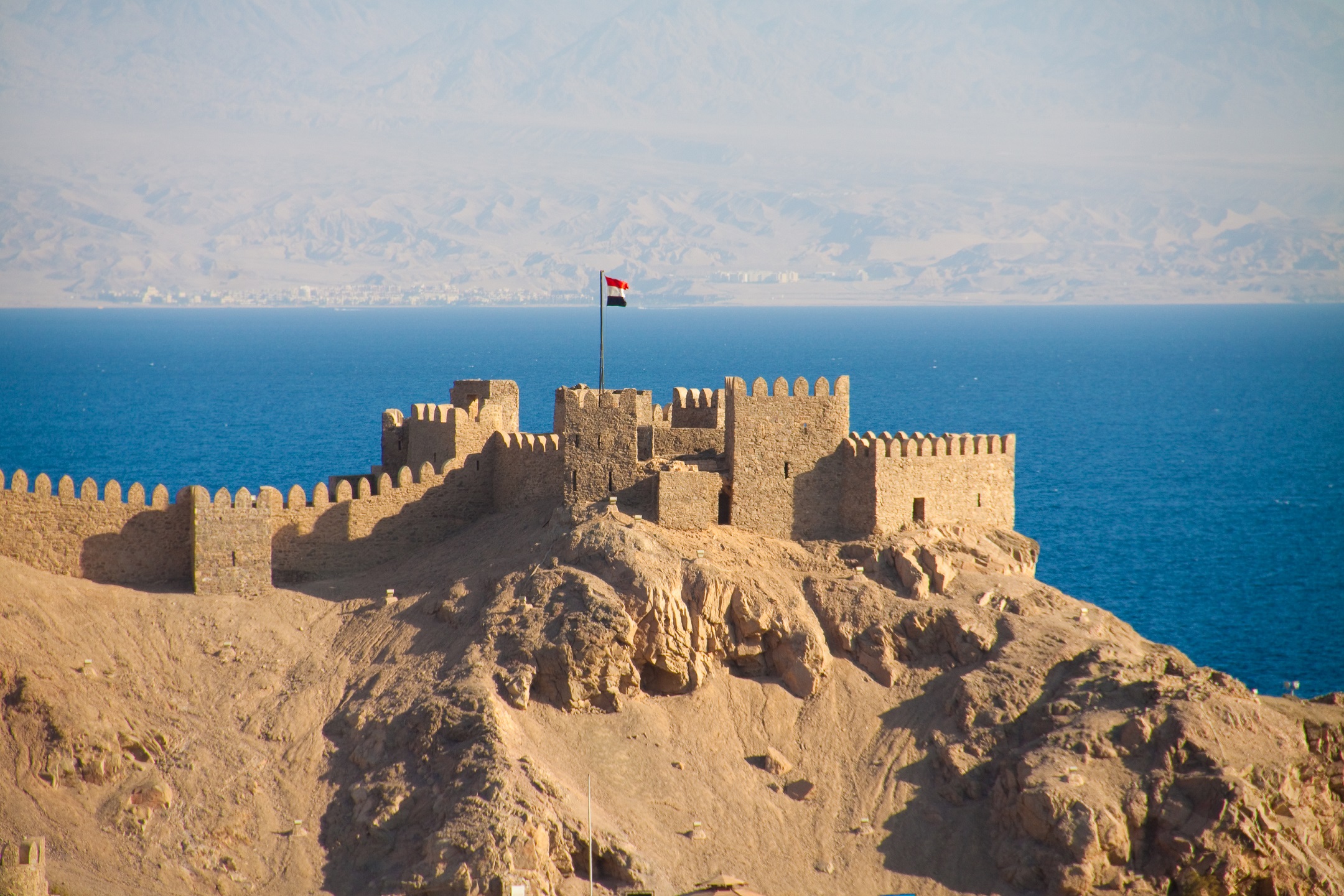Publications
Special Publication, May 19, 2022
In Egypt’s eight years under President Abdel Fattah el-Sisi, a series of major projects have been planned and launched in the Sinai Peninsula. 2022 marks the 40th anniversary of Israel’s withdrawal from Sinai, yet alongside significant progress in the area’s development, many challenges still lie ahead, including ongoing insurgency in northern Sinai, the discontent among some of the Bedouin population, and the shortage of necessary financial resources. Successful development of the Sinai Peninsula is also an Israeli interest, as it could help stabilize the situation in the Gaza Strip and its southern borders.
On April 25, 2022, Egypt marked the 40th anniversary of the liberation of Sinai. The importance of Sinai as a top priority in Egypt's national security has become more prominent since Egyptian President Abdel Fattah el-Sisi took office. Time and again el-Sisi has emphasized his regime's commitment to the people of Sinai, apologizing for the many years of neglect by previous Egyptian regimes.
In October 2021, in a press conference titled "Crossing to the Future" commemorating the 1973 war, the Egyptian president highlighted that even if years have gone by and Sinai has not been developed as it should, the peninsula`s present massive development will bring prosperity and safety by improving the lives of its citizens and leading to a new era in the region, free from terror. El-Sisi also emphasized the importance of the war on terror and the sacrifices that the people of Sinai have undergone in this ongoing battle. This theme was even more pronounced in a speech given by the president on the 40th anniversary of Sinai Liberation Day, where he thanked the Sinai population for their ongoing sacrifice in the war on terror on behalf of the Egyptian people.
Clearly the current development of Sinai is not just a gesture of goodwill by the government toward its local population, but also a part of Egypt's efforts to eradicate terror. Over the past decade, terrorism in Sinai`s northern governorate has led to the loss of thousands of lives of Egyptian civilians and military and security forces, and prompted ongoing instability. According to official statistics, from 2013 to April 2022 the war on terror in Sinai has taken the lives of 3277 security personnel, while 12,280 were seriously injured.
The Sinai insurgency is fueled by localized grievances as well as wider regional developments. Its upsurge was boosted partly by the 2011 and 2013 revolutions, which created a conducive environment for insurgency against the Cairo regime, and partly by the influx of ISIS foreign elements, as some local Bedouin tribes have joined militant Salafi-jihadi groups in a “marriage of convenience.”
As President el-Sisi implicitly admitted, a major underlying cause of the conflict is Bedouin anger at the Egyptian state’s longstanding economic, social, and political policies that discriminate against and marginalize the Bedouin. These include insufficient political representation of the Bedouin, denial of land rights, and exclusion from the Sinai’s tourist industry – a major source of revenue for Egypt and employment for migrant Nile Valley Egyptians. Denied legitimate economic opportunities, some Bedouin elements have turned increasingly to illicit activities, notably smuggling of weapons, drugs, and goods to Gaza and Israel.
While the Egyptian military has conducted several operations against the ISIS-affiliated Wilayat Sinai, particularly the Comprehensive Operation Sinai 2018, it has not yet been able to eliminate or defeat it entirely. Moreover, Egypt’s counterterrorism strategy has occasionally proven counterproductive. Instead of eliminating and rooting out terrorism, it has created fertile ground for radical groups to thrive, recruit new members, and intensify their attacks.
To avoid further alienation and discrimination of the Bedouin population living in the peninsula, Cairo reached the conclusion that social and economic reform is imperative for the fight against terrorism and realized the need for a larger strategy. This comprehensive approach to combating terrorism, is based on three main principles: the first relates to ensuring and achieving the security of the citizen; the second is devoted to restoring the prestige of the state and its control over all parts of the country; and the third relates to restoring confidence in the agencies concerned with controlling security and achieving stability, through relying on an integrated set of axes: security, military, legislative, intellectual, economic, social and development.
Indeed, the development of the Sinai Peninsula and the improvement of its infrastructure have become in the last years one of the national priorities undertaken by el-Sisi`s regime. Yet in actuality, this goal was also targeted by former Egyptian governments since the restoration of the peninsula to Egyptian sovereignty in April 1982, and none have been able to build an inclusive development strategy and translate these plans fully into results on the ground. The current effort is probably the most ambitious, but many obstacles still lie ahead.
Strategy for Development of Sinai during the el-Sisi era
Since 2013 the el-Sisi regime has worked on plans to develop the Sinai Peninsula on many levels. However, not until 2016 did the government introduce long-term plans for the development of the peninsula aiming to increase investments and focus on population-centered projects. According to a report by al-Marsad al-Masry, these plans to date have consisted of a massive budget worth 600 billion EGP ($11.09 billion) to carry out developmental projects in the Sinai Peninsula. The Sinai governorates’ allocations to development have also increased by at least 300 percent from 2009/2010 to 2019/2020.
The central reconstruction agency, the Egyptian defense forces, and the President`s office have all allocated billions of dollars for the development of Sinai. The projects include plans for a comprehensive network of roads connecting the peninsula to other parts of the country such as the five Suez Canal tunnels (12 billion EGP); residential projects such as the new city of Rafah (1.38 billion EGP); agriculture development including the construction of 11 integrated residential agricultural development clusters (450 million EGP); industrial developments, among them an industrial complex in the Jafafa area (4 billion EGP); water and sewage networks such as the construction of a desalination plant in el-Arish ($10 million); and an energy supply network such as the development of the Northern Sinai gas fields ($187 million).
The objectives of the development plan were announced as part of the "Egypt 2030" vision that aims to offer social welfare and economic growth to Egyptian citizens. In addition to focusing on tourism in Sinai, the government is developing projects in 24 areas, from day-to-day issues as recreation and parks for youth, institutes of higher education, and hospitals, to larger infrastructure projects that aim to connect Sinai to the rest of Egypt and the outside world.
The Egyptian regime has strongly promoted the perception of large-scale development of both northern and southern Sinai (Figures 1 and 2).
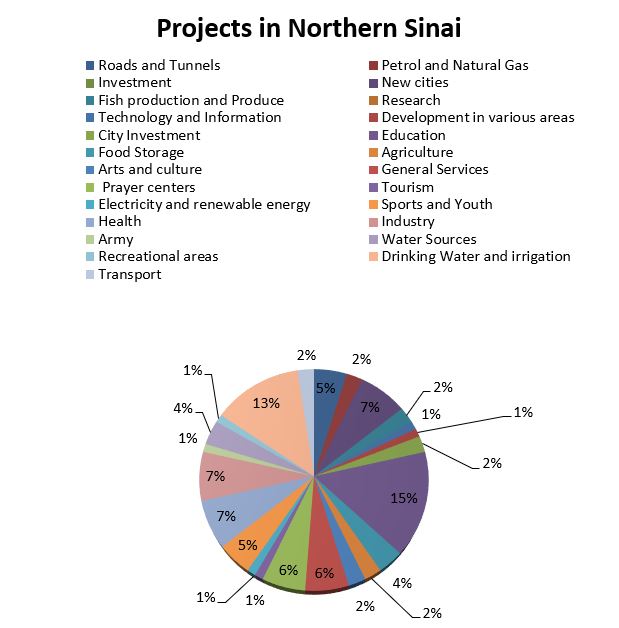
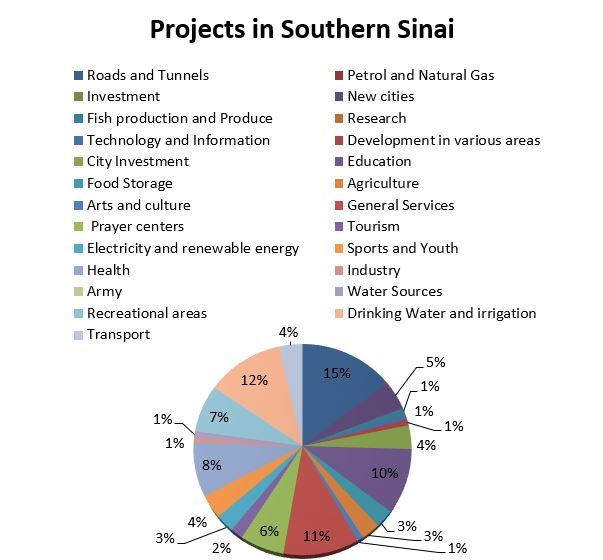
Special emphasis was given to implementation of development projects in northern Sinai, to improve economic opportunities, with varying time frames. This involved legalizations of land ownership for citizens and compensation for damages from military operations. Plans also included building a new city of Rafah because much of the city was destroyed following military airstrikes and the creation of a buffer zone on the Gaza border. By sending reconstruction missions to the conflict-ridden cities of Rafah, el-Arish, Sheikh Zuweid, and Bir al-Abd, the military aimed to garner support and increase its legitimacy.
According to data based on Egypt’s governmental project map portal, there are 112 ongoing and implemented projects in southern Sinai and 90 ongoing and implemented projects in northern Sinai. In the north there are 6 projects under completion while 84 have been completed in various forms. In the south, on the other hand, 10 projects are under completion, while 102 have been completed in various forms (Figure 3). Larger projects of infrastructure and general services are conducted in the south, while more social oriented projects that enhance the day-to-day life of its citizens such as projects of education, health, and culture are being conducted in the north.
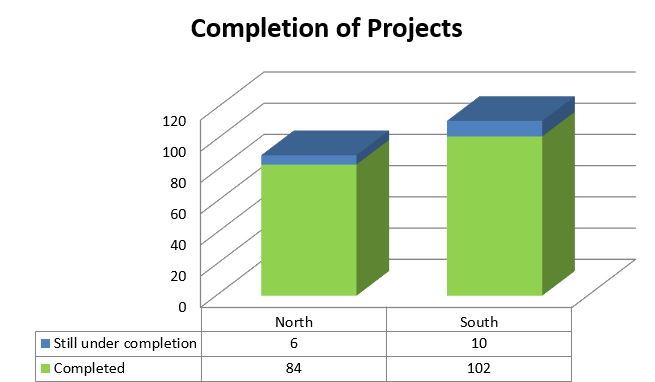
One might have expected more projects to be allocated to the north than the south based on the government's objective of bring equality to the poorer and more damaged northern province that was hit more by terror. However, in analyzing the sums allocated to the north in comparison to the south, available data suggests that the government is still choosing to fund the south more. The government has to date funded 17,339,435,817 EGP in northern Sinai in comparison to 24,575,737,859 in the South (Figure 4).
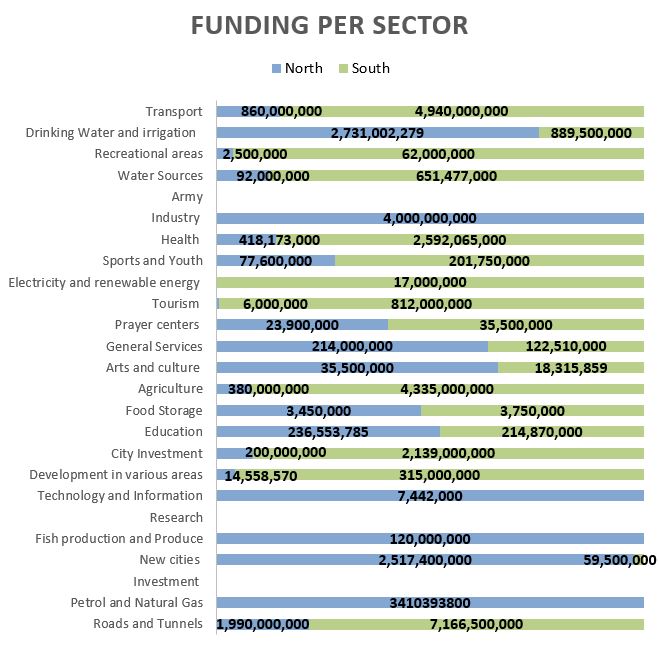
Simultaneously, the government is trying to boast within the Egyptian public opinion its efforts to fight terrorism on the one hand and to develop the Sinai Peninsula for its inhabitants on the other. A video presented at the January 2022 World Youth Forum in Sharm el-Sheikh targeted the epic of construction in Sinai and the unpreceded development, as well as the security and economic opportunities given to the Sinai population. Likewise, the Sharm el-Sheikh Museum, which was opened in 2019, positively highlights the Sinai tribes as an integral part of the fabric of Egypt's society.
Challenges to Sinai Development
While Sinai development sets new records, several challenges remain. The first is the ongoing terror in northern Sinai that has increased in recent months and continues to claim heavy casualties among the military and local population. This in turn may mitigate some of Egypt’s recent achievements, especially in the north.
El-Sisi perceives the war on terror in Sinai as a cornerstone of the stability of Egypt, as the military has to date spent 84 billion EGP to combat the threat. According to a report by the Washington Institute for Near East Policy, terror attacks in Sinai fell from 330 in 2016 to 43 in 2018. After increasing slightly in 2019-2020, they declined again during 2021. Some of this improvement is attributed to the recruitment of members of Bedouin tribes, including Tarabin, Sawarka, and Rumaylat, to fight alongside the Egyptian army to combat terror, even though these tribes often lack formal military training and therefore have difficulty coping with trained terrorist groups.
The expanded presence of local patrols has generally precluded large scales attacks; most incidents now consist of kidnappings or shootings and do not extend beyond the geographic limitations of Sinai’s northeastern and central east territories. Yet despite Egypt’s relative success in reducing attacks and containing the threats, a recent reminder that terrorism is still a significant burden occurred on May 7, 2022, as terrorists attacked a water-lifting station east of the economically strategic area of the Suez Canal, which reportedly resulted in the death of two officers and 15 soldiers.
A second challenge is the negative effect of the war on terror on the Bedouin communities in northern Sinai. While there is lack of unbiased media coverage of developments on the ground, international reports point to human rights violations, forced evacuations, and displacements of local communities. Human Rights Watch and the Sinai Foundation for Human Rights have accused the military of “extrajudicial killings against unarmed people,” as well as “indiscriminate fire and bombings” and “the eviction and occupation of entire villages and towns to combat terrorists.” According to several reports, innocent residents of northern Sinai who returned to the villages they were forced to evacuate found them in complete disarray.
A third related challenge is recruiting the Bedouin communities to support the national development plans. While the picture offered by the regime highlights the reconstruction of northern Sinai, it does not always mirror the reality of destruction and devastation, as it is experienced by part of the indigenous population; efforts in devastated areas continue to fall behind, and much is yet to be done.
Furthermore, in analyzing the projects and the funds allocated, the focus is on the goal of bringing prosperity to all of Egypt rather than on the Bedouin community. The government plans to create new cities and move at least 3 million people to Sinai in the near future, and hopes to eventually increase the number of Sinai residents to 8 million. These plans may drastically affect the traditional life of the Bedouin communities in the peninsula (about 600,000 citizens). As a result, not all Bedouin communities back the regime’s plans and see themselves committed to their success.
Finally, Egypt`s recent social and economic actions support the goal of promoting a more vibrant Sinai. However, there are no clear reports pertaining to the funds needed to complete these ambitious projects and often there is no clear picture of the hierarchy or pecking order of the projects initiated by the various competing agencies.
Sinai`s development requires political will and a clear financing mechanism that will ensure the long-term flow of funds both from the government as well as from foreign sources, even in times of crisis. The economic repercussions of the COVID-19 pandemic have caused the financial situation in Egypt to deteriorate, and have led to the pause and postponement of the completion of many projects. The Russian invasion of Ukraine may further affect the flow of funds to Russian backed projects in the Sinai, particularly in the Suez Canal economic zone.
Implications for the Gaza Strip and Israel
While Egypt is not interested in carrying the burdens of the Gaza Strip on its shoulders, recently it has become more willing than before to play an active role in Gaza’s reconstruction and development – in order to promote its own political, military, and economic interests. Moreover, some of northern Sinai development projects have the potential to alleviate fundamental problems in the Gaza Strip as well.
For example, in the field of transportation, the current expansion of el-Arish sea and air ports may enable export and import of goods to and from Gaza. Similarly, the establishment of water desalination facilities near el-Arish, which are expected to bring water to Rafah, may cross the border and help Gazans address their own shortage of water resources. As for the energy sector, Egyptian plans to build an electricity generation facility in el-Arish may possibly meet some of the Palestinian needs, and at the same time enhance Egypt's strategy of becoming a regional energy hub for its neighbors. Finally, construction of industrial zones near the Rafah border may create jobs and increase mutual trade between both sides as well as decrease illegal trade.
Israel, for its part, has an interest in Egyptian development projects that promote good governance, stability, and welfare across its southern borders, both with the Sinai Peninsula and the Gaza Strip. Thus, it would do well to encourage international and regional donors to offer Egypt economic incentives to adapt some elements of its development strategy in northern Sinai to the needs of the Gaza Strip.
On the bilateral level, Israel and Egypt should work together on expanding their economic relations in Sinai in fields such as tourism, agriculture, and energy. At the same time, both countries should also foster their military cooperation against ISIS, Hamas, and other possible threats that could undermine security in the peninsula, deter foreign capital investments, and obscure the current development efforts.



